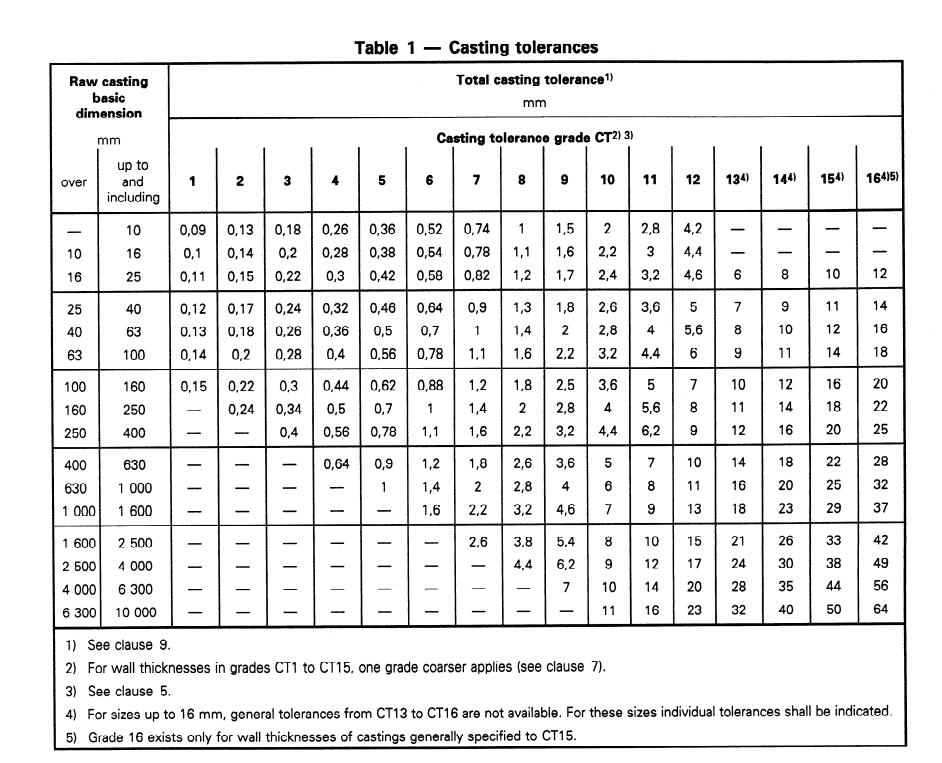+86 311 85258258
+86 311 85258258
Dec. 14, 2021
Casting Tolerances By Different Casting Processes
Dimensional tolerance is an important aspect when we choose the casting process for the preferred castings. In ISO 8062 (corresponding to China's GB/T6414 -1999) standard documents, the tolerance levels of casting dimensions are clearly defined. Usually speaking, investment casting as well as die casting has high accuracy in measurement which's why the investment casting procedure is also called precision casting. Below is the following, you will see the basic tolerances of castings by different casting procedures.
The casting tolerances are divided into Dimensional Casting Tolerances (DCT) and Geometrical Casting Tolerances (GCT). Our foundry would like to talk with you if you have a special request on the required tolerances. Here in the following are the general tolerances grade could reach by our green sand casting, shell mold casting and no-bake furan resin sand casting:
● DCT Grade by Green Sand Casting: CTG10 ~ CTG13
● DCT Grade by Shell Mold Casting or Furan Resin Sand Casting: CTG8 ~ CTG12
● GCT Grade by Green Sand Casting: CTG6 ~ CTG8
● GCT Grade by Shell Mold Casting or Furan Resin Sand Casting: CTG4 ~ CTG7
According to the different binder materials used for making the shell, the investment casting could be divided into silica sol casting and water glass casting. The silica sol investment casting process has better Dimensional Casting Tolerances (DCT) and Geometrical Casting Tolerances (GCT) than the water glass process. However, even by the same casting process, the Tolerance Grade will be different from each cast alloy due to their various castability. Our foundry would like to talk with you if you have a special request on the required tolerances. Here in the following are the general tolerances grade could reach both by silica sol casting and water glass casting processes separately:
● DCT Grade by Silica Sol Lost Wax Casting: DCTG4 ~ DCTG6
● DCT Grade by Water Glass Lost Wax Casting: DCTG5 ~ DCTG9
● GCT Grade by Silica Sol Lost Wax Casting: GCTG3 ~ GCTG5
● GCT Grade by Water Glass Lost Wax Casting: GCTG3 ~ GCTG5
As we mentioned in the casting tolerance for sand castings, the shell mold castings have much higher accuracy and tighter tolerance than sand casting. Here in the following are the general tolerances grade could reach by our shell mold casting and no-bake furan resin sand casting:
● DCT Grade by Shell Mold Casting or Furan Resin Sand Casting: CTG8 ~ CTG12
● GCT Grade by Shell Mold Casting or Furan Resin Sand Casting: CTG4 ~ CTG7
Generally speaking, the casting tolerances of lost foam castings are better than sand casting but worse than shell mold casting and no-bake casting processes. For our foundry, we basically could achieve the following casting grades. But we would like to talk with you about the specific castings and then decide what numbers we can provide for you.
● DCT Grade by Lost Foam Casting: CTG9 ~ CTG13
● GCT Grade by Lost Foam Casting: CTG5 ~ CTG8

If the casting drawing or casting process document clearly requires inspection of all dimensions of the casting, all casting dimensions need to be inspected. This situation is usually the first part of the production of castings or the random sampling inspection process during mass production. In small batch production, it is sometimes required to inspect all dimensions of the casting.
In accordance with the requirements specified in the drawings or process documents, the dimensions of the castings need to be inspected for key control dimensions, dimensions with high accuracy requirements, and dimensions that are easily deformed and out of tolerance. This situation is usually applied to the control inspection of the dimensions of mass production on the production line.
PREVIOUS: Guide to Sand Casting